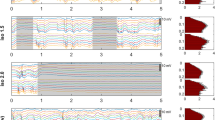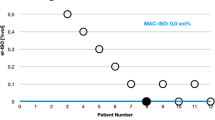Abstract
MANY books recommend chloralose as an anæsthetic for laboratory animals and give a dosage rate of 40–80 mg/kg body-wt.; the drug is considered particularly useful for animals in which autonomic reflexes are to be preserved. I have recently carried out a series of experiments in the dog and rabbit, and in no case did surgical anæsthesia result from intravenous injections of 70 mg/kg or less. If chloralose was used after induction with ether slight improvement was seen, but surgery was still not possible. The heart rate was slowed by 30 per cent in these experiments and excessive secretions caused respiratory embarrassment.
This is a preview of subscription content, access via your institution
Access options
Subscribe to this journal
Receive 51 print issues and online access
$199.00 per year
only $3.90 per issue
Buy this article
- Purchase on SpringerLink
- Instant access to full article PDF
Prices may be subject to local taxes which are calculated during checkout
Similar content being viewed by others
References
Wright, J. G., and Hall, L. W., Veterinary Anæsthesia, fifth ed., 209 (Baillière, Tindall and Cox, London, 1961).
Adrian, E. D., and Moruzzi, G., J. Physiol., 97, 153 (1939).
Hill, D., and Parr, G., Electroencephalography, first ed., 184 (MacDonald, London, 1950).
Grieg, J. R., Hoare's Veterinary Medicine and Therapeutics, fifth ed., 194 (Baillière, Tindall and Cox, London, 1933).
Shukla, R. C., et al., Indian J. Physiol., 16, 17 (1962).
Kochmann, review quoted in Sollmann's Manual of Pharmacology (Saunders, London, 1936).
Author information
Authors and Affiliations
Rights and permissions
About this article
Cite this article
CROFT, P. Actions and Dosage of Chloralose. Nature 203, 1086 (1964). https://doi.org/10.1038/2031086a0
Issue date:
DOI: https://doi.org/10.1038/2031086a0



